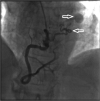Surgical repair of a coronary artery aneurysm associated with coronary artery fistula - a case report
- PMID: 34686096
- PMCID: PMC8544770
- DOI: 10.1177/03000605211053228
Surgical repair of a coronary artery aneurysm associated with coronary artery fistula - a case report
Abstract
Coronary artery aneurysm is a relatively rare disorder that is usually discovered as a secondary finding in patients undergoing coronary artery angiography. Coronary artery fistulas are relatively more frequent than rare aneurysms and are often associated with other cardiac abnormalities. The etiology of aneurysms is mostly atherosclerotic, and they are less frequently associated with other acquired or congenital diseases, such as Kawasaki disease, connective tissue diseases, septic emboli, arteritis, and iatrogenic disease. We report a 70-year-old woman with a rare combination of a coronary artery aneurysm associated with a coronary artery fistula, which drained into the pulmonary artery. The diagnosis of our patient was made by selective coronary angiography and confirmed by computed tomography angiography. The patient was treated surgically because of the symptomatic course of the disease.
Keywords: Coronary artery aneurysm; chest pain; computed tomography angiography; fistula; pulmonary artery; thrombus.
Conflict of interest statement
Figures





References
-
- Roberts WC. Natural history, clinical consequences, and morphologic features of coronary arterial aneurysms in adults. Am J Cardiol 2011; 108: 814–821. - PubMed
-
- Pham V, De Hemptinne Q, Grinda JM, et al.. Giant coronary aneurysms, from diagnosis to treatment: A literature review. Arch Cardiovasc Dis 2020; 113: 59–69. - PubMed
-
- Dodge-Khatami A, Mavroudis C, Backer CL. Congenital Heart Surgery Nomenclature and Database Project: anomalies of the coronary arteries. Ann Thorac Surg 2000; 69: S270–S297. - PubMed
-
- Urrutia-S CO, Falaschi G, Ott DA, et al.. Surgical management of 56 patients with congenital coronary artery fistulas. Ann Thorac Surg 1983; 35: 300–307. - PubMed
Publication types
MeSH terms
LinkOut - more resources
Full Text Sources
Medical

